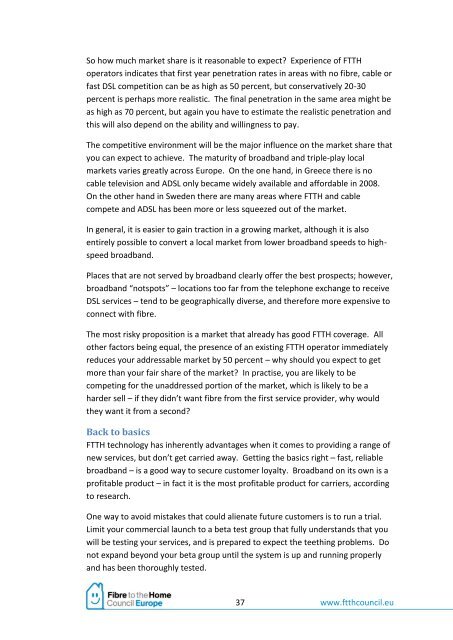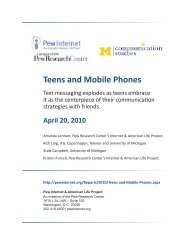You also want an ePaper? Increase the reach of your titles
YUMPU automatically turns print PDFs into web optimized ePapers that Google loves.
So how much market share is it reasonable to expect? Experience of <strong>FTTH</strong><br />
operators indicates that first year penetration rates in areas with no fibre, cable or<br />
fast DSL competition can <strong>be</strong> as high as 50 percent, but conservatively 20-30<br />
percent is perhaps more realistic. The final penetration in the same area might <strong>be</strong><br />
as high as 70 percent, but again you have to estimate the realistic penetration and<br />
this will also depend on the ability and willingness to pay.<br />
The competitive environment will <strong>be</strong> the major influence on the market share that<br />
you can expect to achieve. The maturity of broadband and triple-play local<br />
markets varies greatly across Europe. On the one hand, in Greece there is no<br />
cable television and ADSL only <strong>be</strong>came widely available and affordable in 2008.<br />
On the other hand in Sweden there are many areas where <strong>FTTH</strong> and cable<br />
compete and ADSL has <strong>be</strong>en more or less squeezed out of the market.<br />
In general, it is easier to gain traction in a growing market, although it is also<br />
entirely possible to convert a local market from lower broadband speeds to highspeed<br />
broadband.<br />
Places that are not served by broadband clearly offer the <strong>be</strong>st prospects; however,<br />
broadband “notspots” – locations too far from the telephone exchange to receive<br />
DSL services – tend to <strong>be</strong> geographically diverse, and therefore more expensive to<br />
connect with fibre.<br />
The most risky proposition is a market that already has good <strong>FTTH</strong> coverage. All<br />
other factors <strong>be</strong>ing equal, the presence of an existing <strong>FTTH</strong> operator immediately<br />
reduces your addressable market by 50 percent – why should you expect to get<br />
more than your fair share of the market? In practise, you are likely to <strong>be</strong><br />
competing for the unaddressed portion of the market, which is likely to <strong>be</strong> a<br />
harder sell – if they didn’t want fibre from the first service provider, why would<br />
they want it from a second?<br />
Back to basics<br />
<strong>FTTH</strong> technology has inherently advantages when it comes to providing a range of<br />
new services, but don’t get carried away. Getting the basics right – fast, reliable<br />
broadband – is a good way to secure customer loyalty. Broadband on its own is a<br />
profitable product – in fact it is the most profitable product for carriers, according<br />
to research.<br />
One way to avoid mistakes that could alienate future customers is to run a trial.<br />
Limit your commercial launch to a <strong>be</strong>ta test group that fully understands that you<br />
will <strong>be</strong> testing your services, and is prepared to expect the teething problems. Do<br />
not expand <strong>be</strong>yond your <strong>be</strong>ta group until the system is up and running properly<br />
and has <strong>be</strong>en thoroughly tested.<br />
37 www.ftthcouncil.eu

















